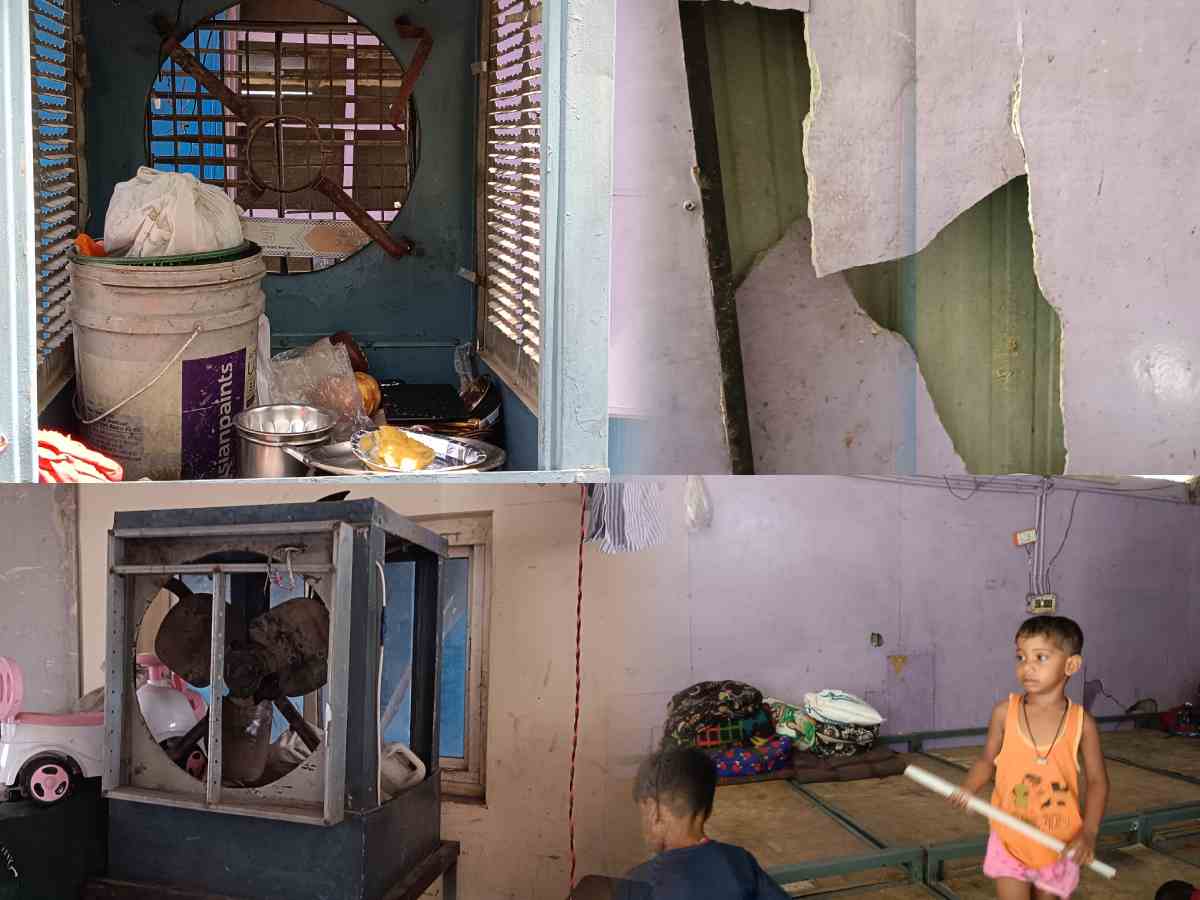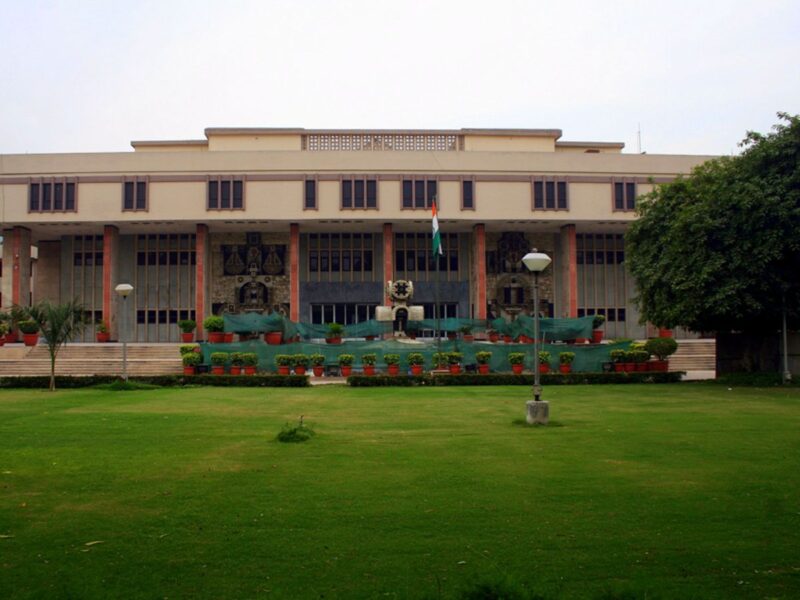Delhi: Gulfsha, 18, wakes her mother up in the early hours of the morning, a habit she built during schooldays. The act is followed by the routine of picking up the bed with her mother, and dragging it across to the courtyard of the night shelter’s property.
Seated in the middle of the allocated land, the mother-daughter duo rest side by side under the shade of a tree. The daily routine is an absolute necessity for them to protect themselves from the rising temperatures in Delhi.
“It is so hot inside. It burns us through and through whenever we are under the tin roof. It is honestly better to sit under the sun because there is, at least, some shade to be found here. Inside it is worst, especially with how populated the room is, and with the coolers not working,” said Gulfsha, who had to stop her schooling to take care of her family, and support them with some additional income.
Also read: Delhi Metro’s Yellow Line services will be affected for two days
What is wrong at these shelters?
Broken coolers and tin roofs spell doom, with the interiors growing hotter as the day proceeds. Such is the story of the night shelters, colloquially known as rain basera, near the Nehru Place Metro Station. The shelters comprise porta cabins – one for families and other only for men. The former overflows with people every day.
Most of the families have been staying inside the quarter for the past decade and a half. Earlier, the cabins were placed at the park in front of Nehru Place Metro Station’s Gate No 2. Following the decision to renovate the park, scores of families were moved to the current location.
Presently, the maximum capacity of the family shelter is 50. However, according to the Occupancy Report, the number of people at night on June 6 was 77, 154% above the maximum capacity.
On the other hand, officials in charge of looking after the shelter highlighted that the total number of people actually staying there was close to 100, with it reaching 125 whenever the entirety of a family decides to return to the national capital from the village.
The residents, who were supposed to be temporary, now stay there indefinitely because getting another place to stay will be much more difficult, if they are ousted.
“I know that it is hot here but even if we complain, it is not like they will hear our pleas and then start installing air-conditioners here,” said Kamla, 39, a resident of the shelter for the past 20 years.
The desert coolers have now taken a backseat, with only four being present at the shelter — two for the shelter for families and two for the shelter meant for men. Out of them, two are dysfunctional while another’s motor does not work.
“We have already placed our complaint with the DUSIB (Delhi Urban Shelter Improvement Board) to fix the coolers but that was in March. The coolers have been dysfunctional since previous year’s winter season. Still after almost six months, they have yet to come to fix these,” said Naushad, a representative from Jan Pahal, an NGO tasked to oversee the shelter.
Earlier on June 3, Delhi Minister of Health Saurabh Bharadwaj had conducted a surprise inspection of shelter homes across the national capital to check whether the establishments were ready for the summer season. He took to X to state that desert coolers and cold water dispensers be made available at all such night shelters.
Who looks after these shelters?
According to the DUSIB, there are 66 permanent night shelters and 83 porta cabin shelters in Delhi. All of the night shelters are looked after by multiple NGOs based in the national capital — Butterflies, Centre for Equity Studies, Manjit Education Society, Sampurna, Jyotik Samajik Sewa Sanstha, Nirmana, Ashray Adhikar Abhiyan, SPYM, DAV Education & Welfare Society, Coalition For Rural Empowerment, Indo Global Social Service Society, IGSSS, Viklang Sahara Samiti, Samarth The Professionals, Santosh, Shree Prem Manav Sewa Samiti, Maitri, Family of Shirdi Sai Baba, Mohini Health Education Research Society, Prayas, Association for Disabled Person, New Indian Education And Social Development Society, Aakansha Samiti, Sahyog Charitable Trust, Humana People to People India, Aditya Education And Social Welfare Society, Janpahal, Association For Public Awareness & Rehabilitation, Child Watch – India, Sadik Masih Medical Social Service Society, Sofia Educational, Ashadeep Foundation, Aradhya, LEDS, Community Welfare Organisation, Abhibhyakti Foundation, Shri Shri Marutnandan Seva Sansthan, The Credence, BMSS, Navlok (B), Mahilayen Pragati ki Ore, UHRC, Sur Nirman, Nirmana, Haq, Shakti Shalini, Nari Uthan Samithi, Saraswati Education Society, Beghar Foundation, Santosh, Navlok, Sahbhagita, AIWCD, and Gyan Gangotri.
“Today I did a surprise inspection of several night shelters at around 3 pm. Although air coolers and cold water dispensers were running at these places, I have instructed the CEO to ensure that the department makes these facilities available at all places,” he wrote on the social media platform in Hindi.
However, after months of disrepair, the coolers have turned into storage spaces, while cold water dispensers stay on the wayside gathering dust because somebody’s child pushed the button too hard, breaking the spring. The dispenser has not worked in the past six months but just like a statistic, it exists overlooking the 30 beds placed under the tin roof. Now, they do not have regular access to water anymore since the tanker has also started to come to the shelter only once a week, while they remain bereft of any sewage or water supply line.
Although the enclosure has an official maximum capacity of 50, the number of beds remains at 30 while the crowd overflows at night. People scream at each other to fight for their right to the final mattress. Not everyone is fortunate enough to sleep on one. Others have to shift to the male quarter if they do not find a spot inside the family quarter. The total capacity gets flouted day in and day out.
Pradhan, 18, has been married for the past three months to Sonia, 17. Both hail from the same village in Rajasthan, though born and brought up in Delhi at the same shelter around the same people that they live with now. The entire family’s life has passed them by ‘living’ in a single cot.
“I have a family of three. All of us use the same bed. Before my marriage, I shared my bed with my brother and his family of four,” he said.
A similar scenario prevails at the night shelter near Hazrat Nizamuddin Railway Station, Sarai Kale Khan.
A massive compound with four night shelters for families, a single building with two floors — ground floor functions as a medical room while the first floor functions as a shelter for men.
At least 500 people stay within the compound, including almost 20 families, according to Asha, a DUSIB worker. Each enclosure has four desert coolers owing to the inflated capacity. The compound can hold 100 people each within each enclosure; however, owing to beds being made available, not everyone is fortunate enough to be privy to a mattress or a bed.
“I have not been allocated a bed because I came much later than all of them. I just sleep on the floor on a cloth. The floor just gets unbearably hot sometimes because of the tin roof and the cooler not working but it is alright. This is the only place I can stay at,” said Chanda, 40.
“Pura shareer garam ho jata hai, ubal jata hai (My entire body, its up, it feels like my skin is boiling),” said a 16 year old resident, requesting anonymity.
Also read: Delhi: Historic printing press building to undergo conservation
Porta cabins and permanent homes
However, not all is lost at these shelter homes as they offer almost a polar opposite scenario at the permanent DUSIB concrete shelter home at Hazrat Nizamuddin Dargah. Cooler interiors with more temporary residents, and newer desert coolers, have made residents there much healthier, leading a comparatively comfortable life. Though multiple persons use a single bed, the heat is still controlled inside.
“I share my bed with my husband and my two sons. It is hot but it is better than resting outside,” said Rashida. The enclosure has 10 rooms, of which six have coolers while three do not. Out of the six, three are yet to be given for servicing.
Aisha Bano, 30, the supervisor from SPYM NGO, said, “We have already asked DUSIB to fix the coolers but till now, there has been no correspondence.”
According to the NGO workers at Porta Cabin night shelters, the residents there have become permanent which has caused the ministry to take congisance of the situation and have them shifted elsewhere.
“They have started giving food according to the maximum capacity of these shelters and they have been pressuring us into getting them shifted to other shelters to help others find shelter here. I do not know where they will go,” said Naushad.
Earlier in March, the Delhi High Court had ordered the inspection of multiple shelter homes in the national capital to ascertain the facilities required to beat the heat during peak summer season. The court had constituted a committee to look into the grievances of the petitioner alleging a dearth in power supply and ineffective bedding.





